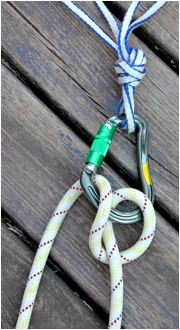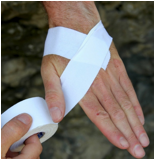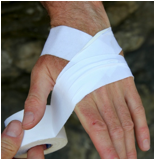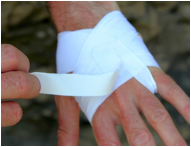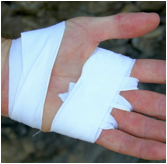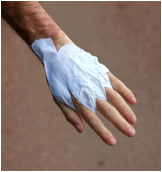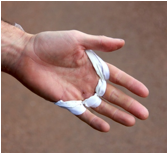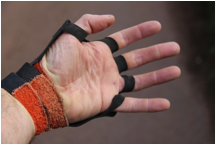--------- multipitchclimbing.com ---------

|
This appendix covers all the knots discussed in the book/website. For a more exhaustive summary of climbing knots see Nigel ShepherdÕs The Complete Guide to Rope Techniques or Graig LuebbenÕs Knots for Climbers. The table summarises each knotÕs use, advantages and disadvantages. A bight refers to a loop of rope which crosses itself, a hitch is a knot tied around something and bends join ends. All knots should be dressed correctly, i.e. the knot should be tight and without twists or loose sections. Dressing a knot makes it easier to spot if you have tied it incorrectly and reduces the likelihood it will come undone when it shouldnÕt.
We also look at the advantages and disadvantages of tying in with a figure of eight or a bowline, how to cut and tie spectra cord, making alpine (sling) draws, tying into the middle of the rope and how to tape so you donÕt bleed on those crack pitches. |
Knots covered in this appendix
|
Alpine butterfly (tied with rope, tied in a sling to form a powerpoint) |
|
|
Munter-mule-overhand (MMO). |
|
|
Bowline (with stopper knot, on a bight, tying in, double, retraced tie in, for a fixed line) |
Overhand (as stopper, on a bight, Euro death knot, rethreaded) |
|
Prusik-Munter-mule-overhand (PMMO) |
|
|
Euro death knot (EDK) |
|
|
Figure of eight (follow through, on a bight, tying in, in-line (directional), easier to release version, self equalised, Yosemite finish) |
|
|
French prusik (in cord, tied with a sling) |
|
|
In-line figure of eight |
Yosemite tuck (finish) |
|
|
|
|
Klemheist (on cord, on tape, around a carabiner, locked off) |
|
|
|
|
1. Figure of Eight or Bowline?
Web forums often discuss at great length whether it is best to tie in with a figure of eight follow through, or a bowline with a half a double fishermanÕs as a stopper knot. Both work fine (as do a variety of alternatives to each). The figure of eight is probably the easier for beginners to tie and the easiest to see if it has been tied correctly, which can be important in the dark when you are cold, wet and tired. It doesnÕt need the addition of a stopper knot, although some climbers include one. It is very much an all-day knot that is stable, and if well tightened, is very unlikely to work loose – which to many means it wins hands down compare to the bowline for multipitch climbing. Almost all of climbing can be achieved (through not very efficiently) with figure of eight knots tied in a variety of ways, hence there is the need to learn less. |
|
|
|
|
A figure of eight follow through (left) and a bowline with half a double fishermanÕs tied close up to the bowline as a stopper (right) are both suitable ways to tie in: each has advantages and disadvantages, but the figure of eight makes for the better all-day knot.
|
|
|
|
|
|
|
If teaching someone to tie in using a figure of eight donÕt encourage them to tie the tail up like this. Leaving a non-structural loop is always a bad idea in case it gets miss-used in error. Simply get them to tie the knot with the correct length of rope and tie the stopper if one is required snug up against the knot. |
|
Against the figure of eight is that it is difficult to untie if it has been loaded. This is a pain on sports climbs and at the climbing gym (wall) where falls are common and you need to frequently tie and untie. In multi-pitch climbing this is rarely a problem, you just donÕt untie that often. However if something goes wrong, you may have to untie, and if injured one handed. Even with two hands it can be very hard to untie a figure of eight if it has experienced a substantial fall; with gloves on it will be impossible. A bowline cannot be left on the rope once it has been untied from the harness. With a figure of eight you can remove it from the harness but leave an ÒeightÓ on the rope. If someone then tries to pull the rope down (say on a sports pitch) the eight might get stuck in the ring. In multipitch climbs, the same can occur if someone lowers off a pitch.
It is also difficult to tie a figure of eight around large objects such as boulders because you have to estimate before you tie the knot how much rope you need. This can lead to an unnecessarily long tail someone might abseil off. (I (DC) did this on Chair Ladder in Cornwall once and it has haunted me ever since.)
Against the bowline is that without the stopper knot it is an accident waiting to happen (it will rapidly come undone or flip into a slip knot), it seems harder for some people to learn and it isnÕt as stable over the whole day. It is harder to tie one handed (if you include the stopper knot), or with gloves on. It also has relatively few other uses. If you have to escape the system, when you untie a bowline does not leave a stopper knot on the rope and therefore no protection in case the Klemheist slips. A good alternative to the normal bowline is a retraced bowline.
It is worth noting that some climbers tie in with a bowline for single pitch sports routes and a figure of eight otherwise. It is also worth noting that stopper knots need to be tied tight and right up against the main knot, not several inches up the rope. This is for two reasons. Firstly, a stopper that is tied right up tight to the main knot is less likely to shake undone (stoppers work themselves undone surprisingly easily with some ropes – meaning your stopper might not be there when you need it). Secondly, leaving a gap between the stopper and the knot creates a loop that might be mistaken for the main tie-in loop (or some other structural element) and used to either belay from or attach the climber to the cliff with. This error has led to at least one death. Although this is most likely to be an issue with beginners, we can all make mistakes in the dark or when a bulky jacket gets in the way of us seeing whatÕs what. Another problem with loose stoppers tied 6 inches up the rope is that when they come undone it is then easy to mistake the tail that is created for the main rope when clipping at waist level. This leaves you not clipped to the piece. I (DC) can speak from personal experience that this is easy to do. The same can occur if you simply tie into the rope in a way that leaves too long a tail, stopper or not. ___________________
Although prusiks can be made from just about anything, soft 5.5mm cord works well on most ropes. For cordelettes 7mm nylon cord is considered a sensible diameter, although some use 5.5mm spectra (dyneema) tied with a triple fishermanÕs. |
|
Knot |
Alternative name |
Use |
Comments |
|
Alpine butterfly |
Butterfly |
Fixed rap lines, powerpoints in slings, attaching haul bags. |
A knot that should be used more because it is much easier than an overhand or figure of eight to untie after loading. |
|
Bowline on a bight |
|
Tying into the middle of a rope when leading or seconding. Or for forming a Banshee belay rig. |
Quick to tie, small and neat. Easy to untie even after loading and even in thin tape or cord. |
|
Bowline with stopper knot |
|
Tying into harness or around a block |
See above. |
|
Clove hitch |
|
Building belays, escaping the system |
Can easily be undone even if previously weighted; cannot be inadvertently left of the rope to snag. |
|
Double FishermanÕs |
Grapevine |
For joining ropes of the same diameter, or for finishing off a bowline. |
Needs practice. Some people just seem to find this a hard knot to tie. |
|
Double overhand |
Double EDK |
Used to join ropes for abseiling. |
Possibly safer than a single overhand, but with more bulk, so it might snag more easily. |
|
Euro death knot |
EDK |
An overhand knot used for joining two ropes of the same diameter for abseiling that has a profile that passes more easily over edges than other knots. |
Leave tails of 60 cm (24 inches). Not as strong as other ways of joining ropes, so only to be used for abseiling. (The knot recommended by Petzl.) |
|
Figure of eight follow through |
|
Tying into harness or around a block |
Very unlikely to work loose over the day. |
|
Figure of eight on a bight |
|
Attaching the rope to a carabiner |
Very unlikely to come undone unexpectedly. |
|
FishermanÕs |
|
Joining cord of the same diameter. |
Easier to tie than a double fishermanÕs, but not as strong so not to be used to join ropes that might experience large forces. |
|
Flat double fish |
|
Used to join ropes for abseiling. |
Very strong for a flat knot, but has a potential failure mode: See the images below. |
|
Flat fish sandwich |
|
Used to join ropes for abseiling. |
Stronger than a EDK and without the propensity to eats its own tails |
|
Flemish bend |
Figure of eight bend |
Good for joining ropes of the same or slightly different diameter for abseiling or other uses. |
Some people find this easier to tie under stress than a double fishermanÕs, possibly because they tie a figure of eight so often. Much stronger than an EDK. |
|
French Prusik |
A form of autoblock |
Escaping the system, third hand for abseils, abseiling past a knot. |
A friction hitch that can be released under load—which is both a pro and a con depending on the situation. Can need a real effort to release it and the release is uncontrolled. A PMMO works better in many situations but needs more time and cord to construct. |
|
Garda |
Alpine clutch
|
Creates a non-return pulley, can be used to ascend a rope in much the same way as a prusik |
Cannot be released under load, creates much more friction than a mini-traxion |
|
Girth hitch |
LarkÕs foot |
Attaching cowÕs tails and daisies to harnesses and foot prusiks to feet. Used to join slings. |
Also useful for tying pegs off short and for cliff top stakes as an alternative to a clove hitch. |
|
Klemheist |
|
Friction hitch for ascending or descending a rope |
Can be tied with tape or cord, easy to slide up and down the rope, only locks well in one direction. |
|
Mule hitch |
Slippery hitch (slip ÒknotÓ) |
For tying off Munter (Italian) hitches and belay plates |
Always finish with an overhand, or it will be dangerously unstable. |
|
Munter hitch |
Italian Hitch |
Use as an alternative to a belay plate, or as part of a releasable system. |
Very good for lowering from a direct belay. Tends to twist the rope badly, but only if loaded –for example when lowering. |
|
Munter-mule-overhand |
MMO |
Tied off Italian hitch. Used in a variety of self-rescue situations. |
|
|
Overhand knot |
|
Used to stop you abseiling off the end of ropes and, as the finish to the Munter-mule, used to tie off belay plates etc. |
|
|
Prusik knot |
|
Very strong friction hitch that grabs well. Good for ascending or descending ropes. |
Use as your waist prusik if not using a mechanical device. It will grab in both directions so it can partly backup a dangerous ascent to a stuck abseil line. Tends to stick when you donÕt want it to. Cannot be tied well with a tape sling—use a Klemheist instead. |
|
Prusik-Munter-mule-overhand |
PMMO |
A MMO tied in prusik cord with a prusik knot attached to the rope. Used in a variety of self-rescue situations. |
Can work better than a French prusik as it can be released under control, but needs more practice as it is more complex to tie. It also needs more cord than a French prusik. |
|
Square knot |
Reef knot |
Tying a coiled rope around your shoulders. |
Leave long enough tails such that your movements canÕt work the knot undone and cause the rope to be lost. Possibly tie two, one on top of each other to stop this happening. |
|
Triple fishermanÕs |
|
Making prusiks and cordelettes out of spectra/dyneema. |
|
|
Water knot |
Tape knot |
For joining tape. |
Will work loose very easily in some tapes, so only use for temporary fixings (e.g. abseil slings) unless you tape the ends down or pull it very tight. Tails should 10cm (4 inches) or so. |
3. The Essential Knots
|
|
|
|
|
French prusik. The greater the number of turns the more easily it will lock onto the rope. The length of the cord and the diameter or cord also have an impact, so experiment. Making your chalk bag cord of a suitable length and diameter is a good tip as you will then always have at least one prusik. |
||
|
|
|
|
French prusik tied with a sling. Note how this 60 cm sling has been shortened with an overhand knot above the stitching in the sling. |
|
|
|
|
|
Klemheist on tape.
|
|
|
|
|
|
Around a carabiner – this sides more easily, but will not lock as well so it only useful for prusiking.
|
|
|
|
Another way of stopping a Klemheist from sticking is to lock it off with a half hitch. |
|
|
|
|
|
|
|
Overhand (aka the Euro death knot, or EDK) used to join two ropes for rappelling. The tails should be at about 45cm (1ft 6inches) but not too long, or someone might mistake a tail for the rope. (Others have used the term EDK in reference to a flat figure of eight—a knot which should never be used to join ropes when abseiling.) |
|
|
|
|
|
|
|
|
|
|
|
Alpine butterfly tied with rope. In the third step it is important that the third wrap around the hand is laid between the first two wraps. This is simpler than it looks. (There are many other ways of tying an alpine butterfly and most climbers who use alpine butterflies have a favourite method.) If you want a longer loop (of maybe a few metres) try this method: https://www.youtube.com/watch?feature=player_embedded&v=_hTH-Luv7VY |
|
|
|
|
|
For two-point anchors, an alpine butterfly tied in a sling can be used to form a powerpoint that is easy to untie even when it has been heavily weighted. Start by wrapping the sling around a finger rather than a hand. With practice this is almost as easy and quick to tie as an overhand. |
|
|
|
||
|
Powerpoints can be formed by tying an overhand (left), a figure of eight (middle), or a figure of nine (i.e. a figure of eight with an extra turn, right). Many people feel using a figure of eight makes the knot easier to untie after a heavy loading, and a figure of nine easier still. However, the more wraps in the knot the more material it will use – although this can be a good thing if the cordelette is slightly to long for the placements used. |
||
4. Good Knots to Know
|
|
|
|
|
|
|
Water (tape) knot. This is not stable for the long term but is fine for abseil slings if tightened. If you find one in-situ make sure the tails are at least 10 cm (3 inches) long and the knot cinched down. (See http://www.caves.org/section/vertical/nh/46/nh46.html for a discussion of cyclic testing of water knots.) |
|
|
|
|
||
|
|
|
||
|
Bowline with stopper knot. The stopper (one half of an double fishermanÕs) needs to be tightly tied and right up against the bowline. |
|||
|
|
|
|
|
|
|
|
|
|
|
Retraced bowline. This is a bowline on a bight tied by rethreading the end. It is possibly safer than a normal bowline as even if part of it comes undone you still have a normal bowline left. You would also probably notice this had happen even in the dark, as the tail would reach your knees. It still doesnÕt feel like an all day knot in the way a figure of eight does. |
|||
|
|
|
|
Single fishermanÕs. Only for use on cords such as prusik loops and autoblocks; use a double fishermanÕs for tying climbing ropes together. (Use a triple fishermanÕs for tying spectra cords.) |
|
|
|
|
|
Garda hitch / alpine clutch. Start by clipping the rope through both carabiners, then back over just one of them in a loop. This creates a non-return pulley much like a mini-traxion. The pull rope is the one that exits between the between the carabiners. It will work at its best if the two lockers are similar. Although it works, it is a high friction solution and a mini-traxion will work much better. A Reverso can also be used as a clutch with thin ropes, and will also work with two ropes. Note the gates are on the same side (this helps stop one of the ropes riding up one of the carabiners and making the knot less easy to work).
|
|
|
|
|
|
Square (Reef) knot.
|
Granny knot. Make sure you donÕt tie one of these when you meant to tie a square knot—this is a common cause of people dropping their ropes when carrying them rucksack style.
|
|
|
|
|
|
|
|
A bowline on a bight: used to make a connecting sling when belaying using a Banshee rig. |
|
|
|
|
|
Triple FishermanÕs (used for tying Spectra cords). Tied like a double fishermanÕs but with an extra turn. |
Spectra canÕt be simply cut and sealed with a hot knife like nylon cord. Instead, cut the cord, pull the sheath over the core to enclose it and then seal just the sheath together with the hot knife. |
|
|
|
|
|
|
|
|
|
Munter-mule-overhand (MMO). Used to tie off a Munter hitch. The mule-overhand part is used to tie off a belay plate. Tie a Munter hitch first, then a mule knot (a slip knot) and finish with an overhand. This can be untied under load. If there is no load on the Munter, then before you tie the mule knot, make sure the Munter is correctly orientated by pulling the rope that will be loaded when the knot is used. This will make sure the finished knot wont flip over the carabiner bar when it is loaded and helps to make sure you tied the mule and overhand on the correct strand. |
||
|
|
|
|
|
Mariner hitch. This makes an easy to tie releasable temporary tether. Note how the loop is passed between the strands in the last step, this is critical. In order you to be able to do this underload the double fishermanÕs needs to be at the other end as it wonÕt pass between the strands. It isnÕt stable if repeatedly unloaded and loaded. |
|
|
|
|
The munter-mariner-overhand makes for a more secure mariner. Start with a munter, do the mariner wraps, pass the tail between the strands and finish with an overhand
|
|
|
|
|
|
|
|
|
|
|
|
A munter-mule-overhand uses a lot of cord, so consider using the munter-halter hitch. This is the same as the MMO except for the finish. A carabiner can be added for extra security if needed. Although good, this knot isnÕt as easy to release as a MMO if loaded. |
|
|
|
|
Top: Prusik-Munter-mule-overhand (PMMO). This is an MMO tied on a long prusik and makes a very useful self-rescue knot. Bottom a French prusik can be used as an alternative in most situations. |
|
|
|
|
|
|
|
A French-mariner can be used as an alternative to a PMMO in many situations. For example, it is much better than a PMMO when passing a knot. Finish with an overhand if to give it more stability. Form it by simply placing a French prusik on the rope and a mariner on the carabiner. |
|
|
|
|
|
|
||
|
|
|
|
|
How to stow a cordelette or sling. With a longer cordelette stage 2 is repeated several times shortening the sling each time.
|
||
|
|
|
|
|
|
Some people like to chain long slings up using slip knots. I find this harder to undo one handed, but the approach does have the advantage that the sling can be stored without a carabiner.
|
|
|
|
|
|
|
|
|
|
|
|
Before you start climbing pull the last knot back out and insert the carabiner. With practice you should be able to clip a piece and unfurl this one handed. |
|
|
|
|
|
|
|
|
|
|
|
|
|
|
A cordelette can also be stowed by forming an overhand or over the shoulder. If you like carrying it this way, cut the cord to just the right length so it fits well and doesnÕt get in the way. |
||
|
|
|
|
Joining two slings with a girth hitch (larkÕs foot).
|
|
|
|
|
|
|
Basket hitch. Often used with a 60cm sling to extend cams over an edge so the carabinerÕs gate canÕt be forced open by the edge. |
|
|
|
|
|
|
|
|
|
|
Thread the bight through the tie-in points and form the hole of the bowline as normal. The rabbit goes up the hole, but instead of going around the tree and back down the hole, pass the loop over your head and then under your feet. Finally adjust the knot to bring it close to the harness |
|
|
|
|
|
|
|
|
Bowline on a bight. |
|
|
|
||
|
A bowline on a bight requires the leader to step through a loop of rope and is therefore a bit awkward to do in a cramped situation. An alternative is to use a re-threaded overhand finished with half of a double fishermanÕs as a stopper. I (DC) cannot find any pull test data for this knot and it could get cross-pulled (e.g. in a fall with runners on both ropes), hence the stopper knot is probably compulsory until more data is available.
|
|||
|
|
|
||
|
|
|
||
|
Another alternative is just a normal bowline, with the end clipped back the tie-in point. |
|||
|
|
|
|
|
A monster Munter. This is useful for lowering a heavy load or to stop the rope from twisting into a mess. In general, a Munter only causes twists if it is loaded, which if it is being used for belaying on long, easy, alpine routes is a rare event. |
||
|
|
|
|
|
|
|
A neat way to stow a prusik loop so it doesnÕt get caught up in the rack and so you donÕt need to waste a carabiner attaching your prusiks to your harness – although for the second having a spare emergency carabiner or two can be useful.
|
5. The Weird and the Wonderful
|
As was mentioned in the Belay chapter, there are other, strange sounding, ways to connect yourself to two- and three-bolt anchors, or trad anchors when the pieces are close together. These include: the self-equalising figure of eight, the bunny knot (or double figure of eight loop) and the triple figure of eight loop. Against them is the difficulty of adjusting the position of the belayer, and for the bunny knot and triple figure of eight knot, remembering how to tie them, especially in stressful situations. (The self-equalising figure of eight is easy to tie.)
If one bolt (or piece) fails with a self-equalising figure of eight on three bolts (pieces) it will extend (a bit like a sliding-X) possibly pulling you off the stance. Personally IÕm (DC) also nervous about the way the knot self equalises by rubbing nylon against nylon if the rope was being prusiked on (thereby creating a sawing action), although there is so much fiction in it might not slide at all. I would not use it with two-bolt (-piece) anchors because, if one of the bolts (or pieces) fails it might be possible for the loop on that side of the knot to be pulled through the knot. This would lead to complete failure of the knot.
Because they donÕt need any slings to form, these strange knots are in theory useful when you are traveling light, and also in self-rescue situations where you might be using the slings for other things. The bunny knot and the triple figure of eight loop are brilliant for forming fixed lines from bolted anchors and for worrying the hell anyone who might be tempted to use your fixed line and hasnÕt seen such knots before. One reason not to use them in a self-rescue situation is that you only really want to be using techniques that you know well when rescuing yourself or your partner. |
|
|
|
|
|
|
|
|
|
A triple figure of eight loop makes a neat way of belaying to three bolts without using a sling, or of fixing a rap line, if you can remember how to tie it. It should also frighten anyone else off from using your fixed line. |
||
|
|
|
|
|
|
|
|
|
|
A bunny knot (or bunny ears) makes a simple way of belaying to two bolts without using a sling, or of fixing a rap line and is another way of stopping people using your fixed line.
|
|
|
When fixing a line semi-permanently to a couple of stables the bunny knot needs to be tied by threading it as follows. |
|
|
|
|
|
|
|
|
|
|
|
|
|
|
|
|
|
|
|
|
When riggering fixed lines using two anchor points a long way from each other, some people prefer to use an inline figure of eight rather than an overhand. This is particular easy to adjust and to untie at the end of the day. It is important than the angle between the arms is not too large (<90 degrees) as the knot will fail if it inverts, this would then be serious if one of the anchors were to also fail. |
|
|
|
|
|
|
|
|
|
|
|
|
|
|
|
|
|
|
|
|
A big flat fish – an alternative rap knot. Start with half a double fishermanÕs (see pull tests at http://www.gudelius.de/spst.htm). Although this knot is plenty strong enough for abseiling and lowing. It has a potential failure mode – see below. |
|
|
|
|
|
Big fat fish failure mode. If the upper fishermanÕs were to catch on the something when the rope was being pulled down, the two parts of the knot could start to part company. This then has a greater possibility of becoming stuck. Note, if the trapped knot is subsequently released, the knot doesnÕt totally fail, but becomes a half fishermanÕs with a stopper knot. I (DC) have not seen any pull test results for such a knot and have no idea if it is safe. However, if this were to happen during the abseil (most likely if you were creeping the knot over an edge) a drop might ensue as the two parts of the knot caught up with each other. This clearly makes it a poor choice as a knot for joining ropes when lowering a climber. It might also be unsafe to prusik back up on a stuck abseil rope joined using this knot. An obvious solution is to place a third half fishermanÕs on the rope to stop any of this happening, however the knot then becomes extremely large. The other solution is just to use an EDK. |
|
|
|
|
|
Flat fish sandwich: an alternative rap knot that solves the problem with the big flat fish discussed above (see pull tests at http://www.gudelius.de/spst.htm). |
|
|
|
|
|
|
If you find a figure of eight (left) difficult to release after loading, finish it with a ÒYosemite tuckÓ. The one in the middle can apparently invert if the rope loop is used to belay from or used as part of the belay, so use the one on the right, and probably only use a Yosemite tuck at the climbing gym as then you wonÕt be anchoring yourself to anything. Watch http://vimeo.com/40767916 to see some Yosemite tucks being pulled apart. |
||
|
|
|
|
A Quay finish. Many climbing gyms (walls) donÕt allow climbers to tie in using a bowline and stopper, but insist on a fig 8 and stopper. One way of making a figure of eight easier to release at the gym is to only clinch down one of the eights. Tie the knot as normal, but more loosely. Then only pull on the main length of rope to clinch the knot tight – this will leave more volume in the knot when you fall. Unlike a Yosemite finish you can now finish with half a double fishermanÕs to keep the belay police off your back, and you safe. |
|
|
|
|
|
|
|
Above and left: An alternative to the Munter-mule-overhand is the Munter-slip-overhand. The difference is that in stage 1 and 2 no twisted loop is formed to pass the bight of rope through. This disadvantage is that the knot doesnÕt lock down as well as a MMO, hence the backup carabiner in the last stage. The advantage is that it is slightly easier to remember how to tie it. One good reason to know it is just so you understand how to form an MMO correctly—you might have been doing it wrong all these years. Below: the first stages of tying an MMO for comparison, the finish is the same: an overhand and possibly a carabiner. |
|
|
|
|
|
|
|
|
|
|
|
|
|
|
|
Double bowline. After stage 3 the knot can either be finished with half a double fishermanÕs around the loop as normal, or as shown with a Yosemite finish (i.e. the stopper goes on the main strand). As this video shows (https://www.youtube.com/watch?v=1dj5Y3h1AEI), a Yosemite finish to a bowline can make the knot fail (you can make this failure happen with either a single and a double bowline with a Yosemite finish) depending on the order you tighten the strands coming out of the knot. So it canÕt be recommend for longer routes as the half a double fishermanÕs (grapevine) stopper can come undone over a day. To be fair, Jim Titt has run some tests on a single bowline with this finish in its failed state. He found the slip knot (which looks a bit like a prusik knot) that forms slides down to the harness, but the resultant knot is as about as strong as a normal bowline. However in this collapsed state the knot is a bit like a normal bowline, in that, if the tail somehow works it way out of the knot total failure will occur. Hence the need from the grapevine stopper. (If you really are having problems trying to sleep, this link should put you on the trail of bunch of ways to backup a bowline: http://igkt.net/sm/index.php?topic=4453.0 . This all possibly suggests that the retraced bowline discussed above is a better alternative. Or better still, use a figure of eight as your multipitch tie-in knot. |
|
|
|
|
|
|
The Zuper Munter. This is similar to a Monster (or Super) Munter, but the additional loop is clipped to a second carabiner. This makes it easier to change back to a Munter if needed during the lower, or to change from a Munter to a ÒMonster-typeÓ Munter without opening the gate of the main locker. |
|
Difficult prusik situations Some good ideas of what to do if you need to prusik up the rope but you donÕt have a Reverso or any slings on you, or if you need to escape the system without using a sling or length of cord can be found here (i.e. prusik knots made using the main climbing rope): http://www.mountainproject.com/v/prussiking-without-any-slings-or-cords/108353040 |
6. Taping Up
Method 1: quick and simple.This method covers the palm (which isnÕt to everyoneÕs liking). To reuse after cutting off, just add a few new turns of tape. |
|
|
|
|
||
|
|
|
A quick way to tape up is to simply wrap the tape around the hand. To re-use cut the tape on the palm, then add more tape next time. |
||
|
|
|
|
|
|
|
If you will be wearing them all day put some tape between your fingers (this ensures the glove doesnÕt ride down the hand and uncover the knuckles). Again, these gloves can be re-used. |
Method 2: Clean palmsSome climbers donÕt like tape on their palms as it reduces contact with the rock. This method wraps around the base of the fingers to leave the palm exposed. With care, these can be re-used as well (by cutting the tape that is wound around the wrist). |
|
|
|
|
|
|
|
|
|
|
|
|
|
|
|
|
This site presents the images from the ebook High: Advanced Multipitch Climbing, by David Coley and Andy Kirkpatrick. In order to keep the cost of the book to a minimum most of these were not included in the book. Although they work best when used in conjunction with the book, most are self-explanatory.
Please use the following links to buy the book: Amazon USA (kindle) / Amazon UK (kindle) / itunes / kobo |
v 21 December 2014
--------- multipitchclimbing.com ---------



















































































































































































































































